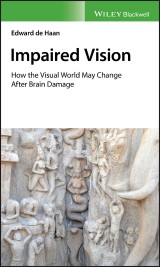Details
Impaired Vision
How the Visual World May Change after Brain Damage1. Aufl.
|
164,99 € |
|
| Verlag: | Wiley-Blackwell |
| Format: | EPUB |
| Veröffentl.: | 26.04.2019 |
| ISBN/EAN: | 9781119423935 |
| Sprache: | englisch |
| Anzahl Seiten: | 288 |
DRM-geschütztes eBook, Sie benötigen z.B. Adobe Digital Editions und eine Adobe ID zum Lesen.
Beschreibungen
<p><b>An unprecedented book that discusses a decades long journey of understanding vision and visual impairment through working with patients with brain damage</b></p> <p>Edward de Haan, a noted clinical vision researcher for the last 35 years, explains how the healthy brain deals with visual information and reveals how he learned to appreciate what it means to be visually impaired. Through discussions of fascinating case studies, he shows that visual deficits are individually unique. Some patients perceive the world without color, some see objects in a distorted manner, whilst others will claim that they can still see although they are demonstrably blind.</p> <p>The author details his experiences with these patients to demonstrate the manner in which patient work is a unique and vital part of discovering how the brain processes visual information. In doing so, <i>Impaired Vision </i>offers a review of the clinical symptoms related to visual impairment and highlights that the patient study method has not lost any of its relevance in our increasingly high-tech world. This important book: </p> <ul> <li>Explores the various clinical phenomena in visual impairment after brain damage</li> <li>Demonstrates the effectiveness of the patient study method for understanding visual deficits after brain damage</li> <li>Contains comprehensive coverage of the variety of symptoms that are manifest in patients with visual impairment</li> <li>Includes compelling case studies of visually impaired patients</li> </ul> <p>Written for a general audience but of interest for students, researchers and clinicians, <i>Impaired Vision</i> contains fascinating case studies that offer an understanding of the symptoms that are associated with visuals deficits of brain damage.</p>
<p>Preface xi</p> <p><b>1 Looking at the Brain 1</b></p> <p>1.1 A Short History 1</p> <p>1.2 The Brain 18</p> <p>1.3 This Book and the Patients in It 23</p> <p><b>2 Blind 29</b></p> <p>2.1 A Blind Eye 29</p> <p>2.2 A Blind Brain 34</p> <p>2.3 Blind Visual Fields 39</p> <p>2.4 Imagined Vision 41</p> <p><b>3 Partially Blind 45</b></p> <p>3.1 Where Is It? 46</p> <p>3.2 Line Orientation 52</p> <p>3.3 Seeing Stroboscopically 56</p> <p>3.4 Shapelessness 58</p> <p>3.5 A Black‐and‐White World 60</p> <p>3.6 Rough and Matte or Smooth and Glossy 66</p> <p><b>4 Looking but Not Seeing 71</b></p> <p>4.1 Wavelength Without Color 71</p> <p>4.2 Day or Night? 77</p> <p>4.3 Seeing Without Reading and Strange Connections 82</p> <p>4.4 What Is That? 87</p> <p>4.5 Lost and an Unfamiliar House 95</p> <p>4.6 Face Failures and a Family Affair 99</p> <p>4.7 I Can’t See Why You Sound Angry and Two Swiss Ladies 103</p> <p>4.8 Classic Syndromes of the Parietal Lobe 108</p> <p><b>5 Seeing Things Differently 113</b></p> <p>5.1 Bringing Color to the World 113</p> <p>5.2 Moldy Faces and Fish Heads 116</p> <p>5.3 Dislodged Vision 125</p> <p>5.4 Repetitive Vision 134</p> <p>5.5 Lost Feelings 138</p> <p><b>6 Seeing What Is Not There 143</b></p> <p>6.1 Bright Sparks 143</p> <p>6.2 Lively Perception in Poor Vision 150</p> <p>6.3 Filling in the Empty Spaces 152</p> <p>6.4 Neglected but Not Forgotten 156</p> <p>6.5 Electrified Perceptions 159</p> <p>6.6 Hallucinations Resulting from Degenerative Disease 163</p> <p>6.7 Visual Hallucinations in Psychiatric Conditions 172</p> <p>6.8 Strange Desires 184</p> <p><b>7 Knowing the Unseen 187</b></p> <p>7.1 Sight Unseen 187</p> <p>7.2 Split Brain 196</p> <p>7.3 Pointing in the Right Direction 202</p> <p>7.4 Vision Without Awareness 209</p> <p>7.5 Ignored but Not Forgotten 216</p> <p><b>8 Oblivion 221</b></p> <p>8.1 Seneca’s Trouble 221</p> <p>8.2 Anosognosia 226</p> <p>8.3 Neglect Revisited 228</p> <p>8.4 Lost Colors 229</p> <p>8.5 My Oil Paintings 231</p> <p>8.6 Forgetting Your Amnesia 235</p> <p><b>9 Vision 241</b></p> <p>9.1 Scope of the Visual Brain 242</p> <p>9.2 Stages of Vision 246</p> <p>9.3 Damage, Deficits, Distortions, and Delusions 251</p> <p>9.4 Consciousness 254</p> <p>9.5 Looking Back 256</p> <p>Index 261</p>
<p><b>Edward de Haan</b> is a distinguished neuropsychologist with both clinical and research appointments. He is Professor of Psychology at the University of Amsterdam, The Netherlands, and has written more than 250 academic papers on vision, perception, memory, and consciousness, as well as on the impact of stroke, diabetes, and schizophrenia. He is President of the Federation for European Societies for Neuropsychology (2018-2019) and he has been an active member of the International Neuropsychological Society (INS) since the mid-1980s. He is an award-winning educator with more than 30 PhD students, many of whom are now also professors themselves.
<p><b>An unprecedented book that discusses a decades long journey of understanding vision and visual impairment through working with patients with brain damage</b> <p>Edward de Haan, a noted clinical vision researcher for the last 35 years, explains how the healthy brain deals with visual information and reveals how he learned to appreciate what it means to be visually impaired. Through discussions of fascinating case studies, he shows that visual deficits are individually unique. Some patients perceive the world without color, some see objects in a distorted manner, whilst others will claim that they can still see although they are demonstrably blind. <p>The author details his experiences with these patients to demonstrate the manner in which patient work is a unique and vital part of discovering how the brain processes visual information. In doing so, <i>Impaired Vision</i> offers a review of the clinical symptoms related to visual impairment and highlights that the patient study method has not lost any of its relevance in our increasingly high-tech world. This important book: <ul> <li>Explores the various clinical phenomena in visual impairment after brain damage</li> <li>Demonstrates the effectiveness of the patient study method for understanding visual deficits after brain damage</li> <li>Contains comprehensive coverage of the variety of symptoms that are manifest in patients with visual impairment</li> <li>Includes compelling case studies of visually impaired patients</li> </ul> <p>Written for a general audience but of interest for students, researchers, and clinicians, <i>Impaired Vision</i> contains fascinating case studies that offer an understanding of the symptoms that are associated with visuals deficits of brain damage.


















